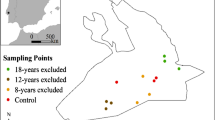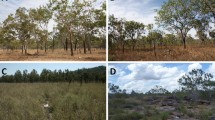Abstract
Ant species diversity was monitored along a mining path rehabilitated four to eleven years previously. The mining path at Hawks Nest (32°30′S, 152°30′E) passes through closed heath and scrub with some open forest patches. Ant species richness, ant species diversity and the number of individuals seemed to be more dependent on the structure of the ant community present than on site variables. The equitability component however showed a linear increase with time, from which it could be predicted that mined plots would not reach the values on control plots in less than 17 years (95% C.I. 13–21 yrs).
An abrupt replacement of species comprising the ant community occurred approximately nine years after rehabilitation. This can be related to replacement of the dominant species and has been interpreted as interspecific competition determining the structure and hence the diversity of the ant community.
Predictive multiple regression equations for species diversity, species richness and the number of individual ants, on mined plots, account for 73%, 79% and 93% of each variance respectively. Independent variables used in the equations were: a floristic component (the absence of a group of plant species found in mature heath); foliage height diversity; the amount of vegetation in vegetation layers (20 to 50 cm and 50 to 100 cm); and soil hardness.
Access this chapter
Tax calculation will be finalised at checkout
Purchases are for personal use only
Preview
Unable to display preview. Download preview PDF.
Similar content being viewed by others
References
Brian, M. V., 1964. Ant distribution in a southern English heath. J. Anim. Ecol. 33: 451–461.
Brian, M. V., Hibble, J. & Stradling, D. J., 1965. Ant pattern and density in a southern English heath. J. Anim. Ecol. 34: 545–555.
Brian, M. V., Mountford, M. D., Abbott, A. & Vincent, S., 1976. The changes in ant species distribution during ten years post- fire regeneration of a heath. J. Anim. Ecol. 45: 115–133.
Briese, D. T. & Macauley, B. J., 1977. Physical structure of an ant community in semi-arid Australia. Aust. J. Ecol. 2: 107–120.
Briese, D.T.& Macauley, B. J., 1980. Temporalstructureofanant community in semi-arid Australia. Aust. J. Ecol. 5: 121–134.
Crowell, K. L., 1968. Rates of competitive exclusion by the Argentine ant in Bermuda. Ecology 49: 551–555.
Fox, B. J., 1979. An objective method of measuring the vegetation structure of animal habitats. Aust. Wildl. Res. 6: 297–303.
Fox, B. J. & Fox, M. D., 1978. Recolonization of coastal heath by Pseudomys novaehollandiae (Muridae) following sand mining. Aust. J. Ecol. 3: 447–465.
Fox, M. D., 1978. Changes in the ant community of coastal heath following sand mining. Bull. Ecol. Soc. Aust. 8: 9.
Gillison, A. N., 1978. Minimum spanning ordination–a graphic-analytical technique for three-dimensional ordination display. Aust. J. Ecol. 3: 233–238.
Gower, J. C., 1966. Some distance properties of latent root and vector methods used in multivariate analysis. Biometrika 53: 325–338.
Greenslade, P.J. M., 1971. Interspecific competition and frequency changes among ants in Solomon Islands coconut plantations. J. Appl. Ecol. 8: 323–352.
Greenslade, P. J. M., 1973. Sampling ants with pitfall traps: digging-in effects. Insectes Soc. 20: 343–353.
Greenslade, P. J. M., 1976. The meat ant Iridomyrmex purpureus (Hymenoptera: Formicidae) as a dominant member of ant communities. J. Aust. Ent. Soc. 15: 237–240.
Greenslade, P. J. M., 1979. A Guide to Ants of South Australia. South Australian Museum Special Educ. Bull. Series, Adelaide, 44 pp.
Greenslade, P. & Greenslade, P. J. M., 1971. The use of baits and preservatives in pitfall traps. J. Aust. Entomol. Soc. 10: 253–260.
Greenslade, P. J. M. & Greenslade, P., 1977. Some effects of vegetation cover and disturbance on a tropical ant fauna. Insectes Soc. 24: 163–182.
Haskins, C. P. & Haskins, E. F., 1965. Pheidole megacephala and Iridomyrmex humilis in Bermuda–equilibrium or slow replacement? Ecology 46: 736–740.
Hurlbert, S. H., 1971. The non-concept of species diversity–a cortique and alternative parameter. Ecology 52: 577–585.
Lieberburg, I., Kranz, P. M. & Siep, A., 1975. Bermudan ants revisited: the status and interaction of Pheidole megacephala and Iridomyrmex humilis. Ecology 56: 473–478.
Majer, J. D., 1972. The ant mosaic in Ghana cocoa farms. Bull. Entomol. Res. 62: 151–160.
Majer, J. D., 1978. Preliminary survey of the epigaeic invertebrate fauna with particular reference to ants, in areas of different land use at Dwellingup, Western Australia. Forest Ecol. Manage 1: 32–34.
Majer, J. D., 1978. Preliminary survey of the epigaeic invertebrate fauna with particular reference to ants, in areas of different land use at Dwellingup, Western Australia. Forest Ecol. Manage 1: 32–34.
Pontin, A. J., 1961. Population stabilization and competition between the ants Lasius flavus (F.) and L. niger (L.). J. Anim. Ecol. 30: 47–54.
Pontin, A. J., 1963. Further considerations of competition and the ecology of the ants Lasius flavus (F.) and L. niger (L.). J. Anim. Ecol. 32: 565–574.
Room, P. M., 1975a. Relative distributions of ant species in cocoa plantations in Papua New Guinea. J. Appl. Ecol. 12: 47–61.
Room, P. M., 1975b. Diversity and organization of the ground foraging ant faunas of forest, grassland and tree crops in Papua New Guinea. Aust. J. Zool. 23: 71–89.
Simpson, E. H., 1949. Measurement of diversity. Nature 163: 688.
Specht, R. L., Roe, E. M. & Boughton, V. H. (eds.), 1974. Conser-vation of major plant communities in Australia and Papua New Guinea. Aust. J. Bot. Suppl. 7: 667 pp.
Thom, B. G., 1965. Late Quaternary coastal morphology of the Port Stephens-Myall Lakes area, N.S.W. J. & =Proc. Roy. Soc. N.S.W. 98: 23–36.
Williams, W. T., 1976. Pattern Analysis in Agricultural Science. C.S. I. R.O., Melbourne.
Editor information
Editors and Affiliations
Rights and permissions
Copyright information
© 1982 Dr W. Junk Publishers, The Hague
About this chapter
Cite this chapter
Fox, M.D., Fox, B.J. (1982). Evidence for interspecific competition influencing ant species diversity in a regenerating heathland. In: Buckley, R.C. (eds) Ant-plant interactions in Australia. Geobotany, vol 4. Springer, Dordrecht. https://doi.org/10.1007/978-94-009-7994-9_10
Download citation
DOI: https://doi.org/10.1007/978-94-009-7994-9_10
Publisher Name: Springer, Dordrecht
Print ISBN: 978-94-009-7996-3
Online ISBN: 978-94-009-7994-9
eBook Packages: Springer Book Archive




